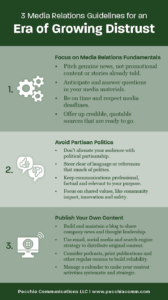5
2025

By Dan Pecchia
A Gallup poll in February confirmed what many public relations professionals and journalists have sensed for years: public trust in the news media is in freefall.
According to Gallup, a record-low 32 percent of Americans say they trust the media “a great deal” or “a fair amount” to report the news “fully, accurately and fairly.” This includes just 12 percent of Republicans, 27 percent of independents, and a still-slipping 54 percent of Democrats.
When fewer than one in three Americans feels confident in the media’s ability to be fair and accurate, it’s time for communications professionals to reassess their approaches. Whether you’re promoting a brand, launching a campaign, or responding to a crisis, this growing skepticism affects how you navigate the media landscape.
Here are three essential guidelines for media relations in an era when trust is in short supply:
1. Focus on Media Relations Fundamentals
Even amid declining trust, the media still play a crucial role in amplifying your message. And getting coverage today still requires more than just writing news releases, sending them off and hoping for the best. The fundamentals of media relations are more important than ever, and here are some ways to respect them:
- Pitch genuine news. Reporters are short on time and long on skepticism. Offer them something truly newsworthy — a compelling story, a surprising development, timely data, a new twist, a promising solution.
- Anticipate and answer questions. News releases and media materials can’t be all about announcing things. They should answer questions reporters, editors and producers are likely to ask. Why now? Who’s affected? How many? What’s different about this? What’s the cost? Where’s the money coming from? When will it be done?
- Be on time and respect deadlines. Journalists work under relentless pressure, and every newsroom is understaffed. Return calls and emails promptly, and never miss an agreed-upon deadline.
- Offer credible, quotable sources. Avoid vague statements from nameless “spokespersons.” Instead, offer up experts or leaders who can speak with authority, clarity and humility. Make sure they’re ready to respond when calls or emails from media pros come in.

Click here for a larger version of this graphic.
At a time when media organizations are short-staffed and under public scrutiny, being a reliable, trustworthy partner to journalists can make the difference between your story drawing interest or getting ignored.
2. Avoid Partisan Politics
The Gallup poll underscores the deep partisan divide in media trust. Republicans, in particular, express overwhelming distrust in the press, but faith among independents and even Democrats is also declining. This signals a dangerous erosion of media credibility across the political spectrum.
For companies and organizations, the takeaway is clear: don’t alienate your audience with political partisanship. Even well-intentioned messages can become lightning rods in today’s hyper-polarized environment.
Steer clear of language, references or talking points that align too closely with either end of the political spectrum (unless of course you’re deliberately advocating for a partisan cause and prepared for the consequences).
Keep communications professional, factual and relevant to your organization’s purpose. Focus on values that resonate broadly — like community impact, innovation and safety — rather than stoking ideological debates that could erode your credibility.
3. Publish Your Own Content
As traditional media faces falling trust and shrinking newsrooms, more brands are building direct channels to their audiences. This is no longer a luxury. It’s a necessity.
If you haven’t yet developed your own publishing platforms, now is the time to start with these basics:
- Build and maintain a blog on your website to share company news and thought leadership.
- Use email, social media and search engine strategy to distribute original content, promote expert commentary and engage your audience directly.
- Consider podcasts, webinars, print publications and other regular communication initiatives to build credibility and reliability while controlling your message.
- Manage a calendar to make your content development and distribution activities systematic and strategic, not random or impulse-driven.
This isn’t about bypassing the media. It’s about complementing your earned media with owned media. Publishing your own content can empower you to speak in your own voice, build long-term trust with your audiences and clarify your messaging before someone else frames it for you.
When your audience can hear directly from you — uncut and unfiltered — you can avoid the effects of media distrust and build lasting credibility.
Conclusion
The drop in media trust is no passing trend. It’s a generational shift. In this new communications environment, PR pros must be smarter, faster and more strategic than ever before.
Master the timeless fundamentals. Avoid the political pitfalls. And invest in telling your story on your own terms.
Trust is harder to earn today, but not impossible. And for those who get it right, it’s more valuable than ever.
_____________
Dan Pecchia, president of Pecchia Communications, spent 11 years in the news business before starting his career in public relations. Reach him at dan@pecchiacomm.com.
Latest Posts
- 3 Media Relations Guidelines for an Era of Growing Distrust May 5, 2025
- Brighten Up Your Brand: 3 Tips for a Summer Messaging Makeover May 5, 2025
- Pecchia Comm Lands 18th Major Change Engagement May 5, 2025
- Student Journalism Awards Lead Press Club’s Plans for 2025 March 6, 2025
- Pecchia Comm Plans $20K Grant to Celebrate 20th Anniversary February 26, 2025
- Power of Print Still Endures in Employee Comms February 5, 2025
- 6 Essential Communications Strategies for Managing Organizational Change February 4, 2025
- Factory Work Instructions Drive Compliance, Consistency February 3, 2025
6725 Pheasant Run Drive | Youngstown, Ohio 44406 | Privacy Policy

